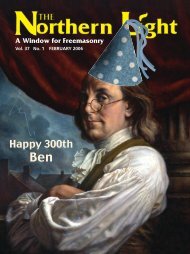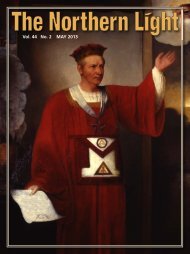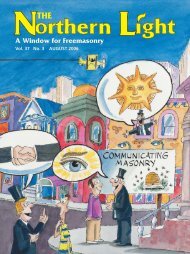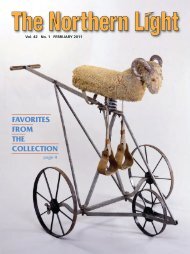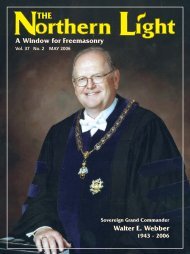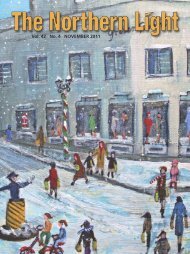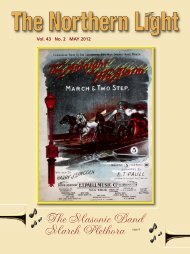The Degree Rituals The Supreme Council, 33 ... - Scottish Rite, NMJ
The Degree Rituals The Supreme Council, 33 ... - Scottish Rite, NMJ
The Degree Rituals The Supreme Council, 33 ... - Scottish Rite, NMJ
Create successful ePaper yourself
Turn your PDF publications into a flip-book with our unique Google optimized e-Paper software.
<strong>The</strong> <strong>Degree</strong> <strong>Rituals</strong><br />
<strong>The</strong> Twenty-fourth “American Indian” <strong>Degree</strong><br />
<strong>The</strong> ritual of the 24°, like that of the 23°, at least in any identifiable form,<br />
was a latecomer to the <strong>Scottish</strong> <strong>Rite</strong> degree system. <strong>The</strong>re was no predecessor<br />
to the current degree ritual preserved as part of the <strong>Rite</strong> of Perfection rituals<br />
in Henry Francken’s 1783 manuscript. <strong>The</strong> traditional title of the degree,<br />
“Prince of the Tabernacle,” was mentioned in 1805 by Jean Frederick<br />
Doszedardski in reference to a French degree, but no details of the ritual were<br />
given. Killian Van Rensselaer’s 1845 manuscript provided signs and words<br />
for the degree, indicating that the lesson was toleration, but nothing more.<br />
Thus, up to the middle of the 19th century, the content of the 24° ritual is unknown.<br />
<strong>The</strong>n, enter Albert Pike. Among the degree rituals he completed in 1855<br />
was a ritual for the 24°. Pike’s source for this ritual remains a mystery. Ostensibly<br />
set in the time of Moses, the ritual meandered through the centuries<br />
in an anachronistic mélange of philosophical ideas. At times it bordered on<br />
the occult, at times on Masonic symbolism, arriving at Pike’s doctrine of<br />
equilibrium. <strong>The</strong>re was no discernible theme. <strong>The</strong> lesson of the degree, in<br />
essence, was God, country, and the pursuit of happiness. It was not Pike at his<br />
best.<br />
Nevertheless, perhaps not only for lack of something better, but simply<br />
for lack of anything else, the Pike ritual was accepted for the 24° of this jurisdiction<br />
after the Union of 1867. Moreover, this ritual continued in use, with<br />
but a few minor changes, for the next 42 years.<br />
Finally, in 1909, the <strong>Supreme</strong> <strong>Council</strong> withdrew the Pike ritual and approved<br />
a new ritual featuring a dramatic allegory for the 24°. <strong>The</strong> primary<br />
author of the new allegory was English-born Ill. John Lloyd Thomas, <strong>33</strong>°,<br />
who later was elected an Active Member for New York and appointed a member<br />
of the Committee on <strong>Rituals</strong>. <strong>The</strong> Thomas Allegory depicted a fictitious<br />
incident during the dedication of King Solomon’s Temple. A discussion on the<br />
nature of God by representatives of various religions was disrupted by a voice<br />
of skepticism. <strong>The</strong> disharmony ultimately was resolved by an eloquent declaration<br />
of the universal faith of service to humanity.<br />
61




